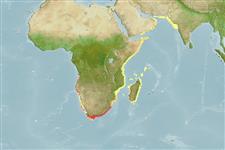Elasmobranchii (sharks and rays) >
Torpediniformes (Electric rays) >
Narkidae (Sleeper rays)
Etymology: Narke: Greek, narke = numbness (Ref. 45335).
Environment / Climate / Range
Ecology
Marine; demersal; depth range 20 - 183 m (Ref. 6589). Subtropical, preferred ?
Southeast Atlantic: Cape Point to central Natal, South Africa. Possibly occurring in Mozambique and Madagascar (Ref. 5578).
Size / Weight / Age
Maturity: Lm ? range ? - ? cm
Max length : 38.0 cm TL male/unsexed; (Ref. 5578)
Short description
Morphology | Morphometrics
Small ray with an almost circular disc and an elongated caudal fin (Ref. 5578). Yellowish-brown above with yellowish patches on upper tail, yellow with brown margins below (Ref. 5578).
Occurs offshore on the shelf; also common on sandy and muddy bottoms at 20-115 m (Ref. 5578). Feeds mainly on polychaetes (Ref. 5578). Capable of giving a powerful shock (Ref. 5578). Incidental catch of trawlers (Ref. 5578).
Life cycle and mating behavior
Maturity | Reproduction | Spawning | Eggs | Fecundity | Larvae
Compagno, L.J.V., 1986. Narkidae. p. 113-114. In M.M. Smith and P.C. Heemstra (eds.) Smiths' sea fishes. Springer-Verlag, Berlin. (Ref. 6589)
IUCN Red List Status (Ref. 115185)
CITES (Ref. 94142)
Not Evaluated
Human uses
More information
Common namesSynonymsMetabolismPredatorsEcotoxicologyReproductionMaturitySpawningFecundityEggsEgg development
Age/SizeGrowthLength-weightLength-lengthLength-frequenciesMorphometricsMorphologyLarvaeLarval dynamicsRecruitmentAbundance
ReferencesAquacultureAquaculture profileStrainsGeneticsAllele frequenciesHeritabilityDiseasesProcessingMass conversion
Tools
Special reports
Download XML
Internet sources
Estimates of some properties based on models
Phylogenetic diversity index (Ref.
82805): PD
50 = 0.6252 [Uniqueness, from 0.5 = low to 2.0 = high].
Bayesian length-weight: a=0.01000 (0.00244 - 0.04107), b=3.04 (2.81 - 3.27), in cm Total Length, based on all LWR estimates for this body shape (Ref.
93245).
Trophic Level (Ref.
69278): 3.1 ±0.26 se; Based on food items.
Resilience (Ref.
69278): Low, minimum population doubling time 4.5 - 14 years (Assuming fecundity<100).
Vulnerability (Ref.
59153): Low vulnerability (20 of 100) .
